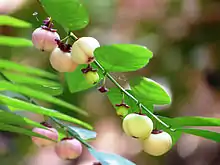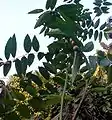Sauropus androgynus
Sauropus androgynus, also known as katuk, star gooseberry, or sweet leaf, is a shrub grown in some tropical regions as a leaf vegetable. In Chinese it is called mani cai (马尼菜); in Japan it is called amame shiba (アマメシバ); in Malay it is called cekur manis, sayur manis, asin-asin or cangkok manis (in Bruneian malay);[4][5] in Thai it is called pak waan (or pak waan ban to distinguish it from Melientha suavis, a completely different plant); in Indonesia, it is called katuk; in Vietnamese, it is called rau ngót; in the Philippines, it is called Chinese Malunggay and in Kerala, India it is called madhura cheera.
| Sauropus androgynus | |
|---|---|
 | |
| Scientific classification | |
| Kingdom: | Plantae |
| Clade: | Tracheophytes |
| Clade: | Angiosperms |
| Clade: | Eudicots |
| Clade: | Rosids |
| Order: | Malpighiales |
| Family: | Phyllanthaceae |
| Genus: | Sauropus |
| Species: | S. androgynus |
| Binomial name | |
| Sauropus androgynus | |
| Synonyms[2][3] | |
|
List
| |
Its multiple upright stems can reach 2.5 meters high and bear dark green oval leaves 5–6 cm long.
It is one of the most popular leafy vegetables in South Asia and Southeast Asia and is notable for high yields and palatability.[6] The shoot tips have been sold as tropical asparagus. In Vietnam, the locals cook it with crab meat, minced pork or dried shrimp to make soup. In Malaysia, it is commonly stir-fried with egg or dried anchovies. The flowers and small purplish fruits of the plant have also be eaten In Indonesia, the leaves of the plant are used to make infusion, believed to improve the flow of breast milk for breastfeeding mothers.
It is a good source of vitamin K. However, a study has suggested that excessive consumption of juiced Katuk leaves (due to its popularity for body weight control in Taiwan in the mid '90s) can cause lung damage, due to its high concentrations of the alkaloid papaverine.[7]
It also has high level of provitamin A carotenoids, especially in freshly picked leaves, as well as high levels of vitamins B and C, protein and minerals. The more the leaves mature, the higher the nutrient content of the leaves.[8]
It is common in evergreen forest and cultivated up to 1,300 m.[9]
Medical
Consumption of Sauropus androgynus has been reported as being associated with bronchiolitis obliterans.[10] [11]
Nutrition
Sauropus androgynus is a good source of β-carotene α- and β-carotenes are partly metabolized into vitamin A. It is rich in Vitamin C providing more than 100% of the Daily Value (DV) per 100 g serving of (288% DV), Iron (23% DV) and Zinc (10% DV).[12] However, the high levels of polyphenols, such as tannin, inhibit the absorption of Zn and Fe.
| Nutritional value per 100 g (3.5 oz) | |
|---|---|
| Energy | 245 kJ (59 kcal) |
11 g | |
1 g | |
4.8 g | |
| Vitamins | Quantity %DV† |
| Vitamin A | 10370 IU |
| Thiamine (B1) | 9% 0.1 mg |
| Vitamin C | 288% 239 mg |
| Minerals | Quantity %DV† |
| Calcium | 20% 204 mg |
| Iron | 23% 3 mg |
| Phosphorus | 14% 98 mg |
| Potassium | 10% 457 mg |
| Sodium | 2% 25 mg |
| Zinc | 10% .94 mg |
| Other constituents | Quantity |
| Water | 91.4 g |
| |
| †Percentages are roughly approximated using US recommendations for adults. | |
 Leaves and fruits Sauropus androgynus
Leaves and fruits Sauropus androgynus Sauropus androgynus
Sauropus androgynus
References
- Under its currently accepted name of Sauropus androgynus (from its basionym Clutia androgyna) this species was published in Bulletin of the Bureau of Forestry, Philippine Islands. Manila 1: 30. 1903. "Name – Sauropus androgynus (L.) Merr". Tropicos. Saint Louis, Missouri: Missouri Botanical Garden. Retrieved November 18, 2012.
Basionym: Clutia androgyna L.
- The basionym of S. androgynus (Clutia androgyna) was originally described and published in Mantissa Plantarum 1: 128. 1767. "Name – Clutia androgyna L." Tropicos. Saint Louis, Missouri: Missouri Botanical Garden. Retrieved November 18, 2012.
- "TPL, treatment of Sauropus androgynus". The Plant List; Version 1. (published on the internet). Royal Botanic Gardens, Kew and Missouri Botanical Garden. 2010. Retrieved November 18, 2012.
- Coope, A.E. (1993). Malay-English, English-Malay Dictionary (Rev. ed.). New York: Hippocrene Books. pp. 18, 61. ISBN 0-7818-0103-6.
- Bangchik (2009-10-08). "Cups in the air. asin-asin". Retrieved 2010-05-18.
- "Nutritive value of Sauropus androgynus".
- Kao CH; Ho YJ; Wu CL; ChangLai SP (1999). "Using 99mTc-DTPA Radioaerosol Inhalation Lung Scintigraphies to Detect the Lung Injury Induced by Consuming Sauropus androgynus Vegetable and Comparison with Conventional Pulmonary Function Tests". Respiration. Karger AG. 66 (1): 46–51. doi:10.1159/000029336. PMID 9973690.
- 19.1 Sauropus androgynus (sweet leaf bush)
- "Globinmed – Globinmed". www.globinmed.com.
- Oonakahara, Kenichi; Matsuyama, Wataru; Higashimoto, Ikkou; Machida, Kentarou; Kawabata, Masaharu; Arimura, Kimiyoshi; Osame, Mitsuhiro; Hayashi, Miho; Ogura, Takashi; Imaizumi, Kazuyoshi; Hasegawa, Yoshinori (2005). "Outbreak of Bronchiolitis obliterans Associated with Consumption of Sauropus androgynus in Japan – Alert of Food-Associated Pulmonary Disorders from Japan". Respiration. 72 (2): 221. doi:10.1159/000084058. PMID 15824537.
- Lai, Ruay-Sheng; Chiang, Ambrose A; Wu, Ming-Ting; Wang, Jyh-Seng; Lai, Nin-Sheng; Lu, Jau-Yeong; Ger, Luo-Ping; Roggli, Victor (1996). "Outbreak of bronchiolitis obliterans associated with consumption of Sauropus androgynus in Taiwan". The Lancet. 348 (9020): 83–85. doi:10.1016/S0140-6736(96)00450-3. PMID 8676721.
- Nguyen, Khan (2007). Vietnamese Food Composition Table. Hanoi: Ministry of Health, National Institute of Vietnam. p. 168.
External links
| Wikimedia Commons has media related to Sauropus androgynus. |